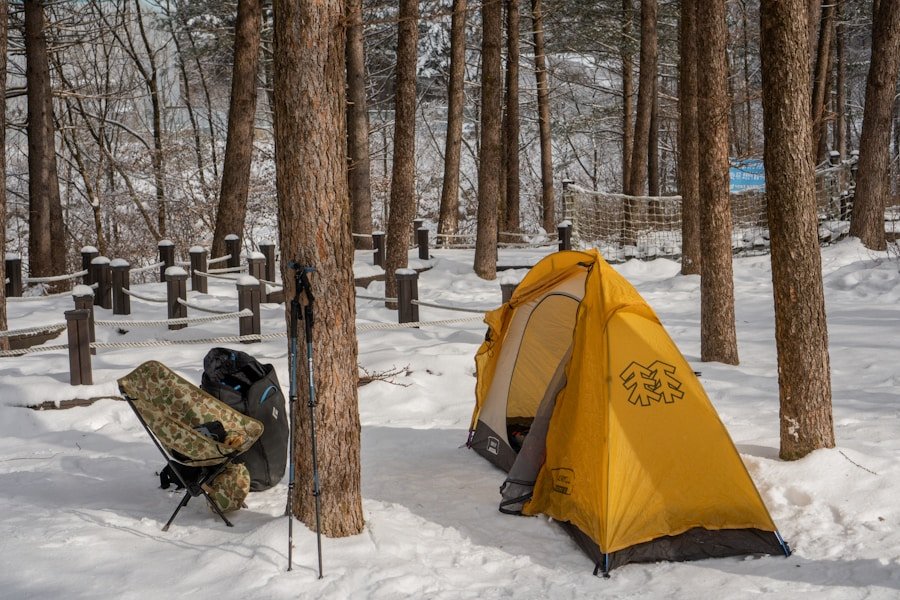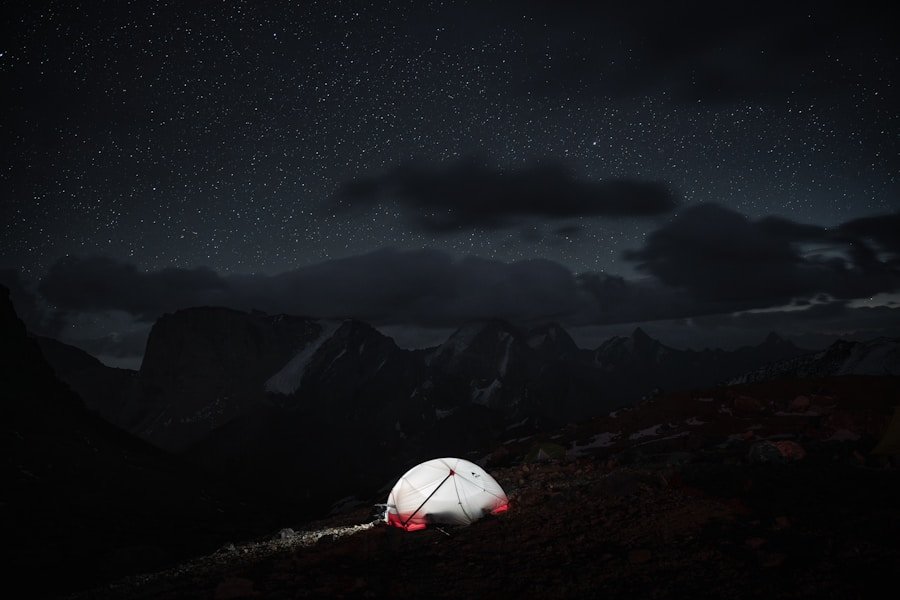When planning a camping trip, it is crucial to consider the weather forecast to ensure a safe and comfortable experience. Understanding the forecast enables campers to prepare for potential weather changes and pack the necessary gear and supplies. Before embarking on a camping adventure, it is essential to check the forecast for the specific area, focusing on temperature, precipitation, wind speed, and any severe weather alerts.
The timing of expected weather changes is also vital, as it allows campers to plan activities and prepare for sudden shifts in conditions. Furthermore, the terrain and elevation of the camping location can impact local weather patterns, making it essential to consider these factors as well. In addition to pre-trip forecasting, it is recommended to monitor the weather during the camping trip.
Many smartphones offer weather apps that provide real-time updates on current conditions and impending storms or severe weather. For areas with limited cell service, consider bringing a portable weather radio or satellite communicator to stay informed about forecast changes. By staying aware of weather conditions, campers can make informed decisions about their activities and take necessary precautions to ensure safety in changing weather.
Key Takeaways
- Always check the weather forecast before heading out for a camping trip
- Pack essential gear for changing weather conditions, including rain gear and extra layers
- Choose a campsite location that is sheltered and resistant to inclement weather
- Plan and prepare meals that are easy to cook in stormy conditions
- Follow safety precautions and have an emergency communication plan in place for stormy conditions
Essential Gear for Camping in Changing Weather
Choosing the Right Tent
One of the most important pieces of gear for inclement weather camping is a high-quality tent that is designed to withstand wind, rain, and even snow. Look for a tent with a durable rainfly, waterproof seams, and a sturdy frame that can handle strong gusts of wind.
Dressing for the Occasion
In addition to a reliable tent, it’s important to have appropriate clothing for varying weather conditions. Pack layers that can be easily added or removed as the temperature changes, including moisture-wicking base layers, insulating mid-layers, and waterproof outer layers. Don’t forget to bring extra socks and footwear that can handle wet and muddy conditions.
Other Essential Gear
Other essential gear for camping in changing weather includes a quality sleeping bag rated for cold temperatures, a portable stove or campfire cooking equipment, and a reliable source of light such as a headlamp or lantern. By having the right gear on hand, you can stay comfortable and safe no matter what Mother Nature throws your way.
Tips for Setting Up a Weather-Resistant Campsite
When setting up your campsite in changing weather conditions, there are several tips to keep in mind to ensure that your camp is prepared for whatever comes your way. First and foremost, choose a campsite that offers natural protection from the elements, such as a location with natural windbreaks or tree cover. If possible, avoid setting up camp in low-lying areas that are prone to flooding during heavy rain.
Once you’ve chosen a suitable location for your campsite, take the time to properly secure your tent and other gear to prevent them from being damaged by wind or rain. Use sturdy tent stakes and guylines to anchor your tent, and consider using additional tarps or rainflies for added protection. In addition to securing your shelter, take steps to protect your cooking and food storage areas from inclement weather.
Set up a designated cooking area with a tarp or canopy to shield your stove or campfire from rain, and use bear-proof containers or hanging systems to store food safely away from wildlife. Finally, be mindful of the impact of your campsite on the environment, especially in wet or fragile ecosystems. Avoid trampling vegetation or creating new trails, and follow Leave No Trace principles to minimize your impact on the natural surroundings.
By taking these precautions when setting up your campsite, you can create a comfortable and weather-resistant base for your outdoor adventure.
Food and Cooking Considerations in Inclement Weather
| Weather Condition | Preparation |
|---|---|
| Sunny Skies | Bring sunscreen, hats, and sunglasses. Stay hydrated. |
| Partly Cloudy | Keep an eye on the sky for potential changes. Bring a light jacket. |
| Overcast | Be prepared for potential rain. Pack a waterproof jacket and extra socks. |
| Stormy Weather | Seek shelter immediately. Stay away from tall trees and metal objects. |
When camping in stormy conditions, it’s important to plan ahead for your food and cooking needs to ensure that you can still enjoy delicious meals despite the weather. One of the most important considerations for cooking in inclement weather is choosing the right fuel source for your stove or campfire. If you’ll be camping in wet conditions, bring plenty of waterproof matches or a reliable fire starter to ensure that you can still cook over an open flame.
Additionally, consider bringing a portable stove that can be used safely under a tarp or canopy if rain makes it difficult to start a campfire. In addition to choosing the right cooking equipment, think about the types of meals that are best suited for stormy weather camping. Opt for simple recipes that require minimal prep and cooking time, such as one-pot meals or foil packet dinners that can be easily cooked over a campfire or stove.
Pack plenty of non-perishable foods that can be enjoyed without cooking, such as trail mix, energy bars, and canned goods. Finally, don’t forget to bring plenty of hot drinks like coffee, tea, or hot cocoa to warm up on chilly, rainy days. By planning ahead for your food and cooking needs, you can still enjoy delicious meals even when the weather doesn’t cooperate.
Safety Precautions for Camping in Stormy Conditions
Camping in stormy conditions requires extra precautions to ensure that you stay safe and comfortable despite the challenging weather. One of the most important safety considerations is staying aware of changing weather conditions and being prepared to take shelter if necessary. Keep an eye on the sky for signs of approaching storms, such as dark clouds, lightning, or sudden changes in wind speed.
If severe weather is imminent, seek shelter in a sturdy building or vehicle if available, or hunker down in your well-secured tent with all openings closed. In addition to staying aware of changing weather conditions, take steps to protect yourself from potential hazards associated with stormy weather. Avoid setting up camp near tall trees or other objects that could pose a risk of falling during high winds.
Secure loose items around your campsite, such as chairs, coolers, and cooking equipment, to prevent them from being blown away or causing damage. Finally, be mindful of the potential for flash flooding in low-lying areas during heavy rain, and avoid crossing swollen streams or rivers on foot. By taking these safety precautions when camping in stormy conditions, you can minimize the risks associated with challenging weather and enjoy a safe outdoor adventure.
Emergency Preparedness and Communication Plans
Inform Others of Your Itinerary
Before embarking on your trip, ensure that someone not part of your camping group is aware of your itinerary and expected return date. This way, if you encounter unexpected challenges due to stormy weather or other factors, someone will know when to raise the alarm if you don’t return as planned.
Packing Essential Emergency Supplies
In addition to having a communication plan in place, it’s essential to bring along vital emergency supplies in case of unexpected challenges during stormy weather camping. Pack a well-stocked first aid kit that includes supplies for treating common outdoor injuries as well as any specific medical needs of members of your group. Consider bringing emergency signaling devices such as whistles or signal mirrors that can be used to attract attention if needed.
Emergency Preparedness and Response
Finally, ensure that every member of your camping group knows how to use any emergency equipment you bring along and understands the plan for responding to different types of emergencies. This will help ensure that everyone is prepared and knows what to do in case of an emergency.
Making the Most of Your Camping Experience, Rain or Shine
While stormy weather can present challenges during a camping trip, it’s still possible to make the most of your outdoor adventure regardless of the conditions. Embrace the opportunity to enjoy activities that are well-suited for rainy or windy weather, such as birdwatching from under a sheltered area or taking a leisurely hike through misty forests. Bring along games or books that can be enjoyed inside your tent during periods of heavy rain or strong winds.
Additionally, take advantage of breaks in the weather to explore the natural beauty of your camping location without worrying about crowds or excessive heat. Capture stunning photos of rain-soaked landscapes or misty mountainsides that offer a unique perspective on familiar outdoor scenes. Finally, remember that challenging weather conditions can create opportunities for bonding with your camping companions as you work together to stay comfortable and safe despite the elements.
By maintaining a positive attitude and embracing the unique experiences that stormy weather camping offers, you can make lasting memories and enjoy an unforgettable outdoor adventure rain or shine. In conclusion, camping in changing weather conditions requires careful planning and preparation to ensure that you stay safe and comfortable regardless of what Mother Nature has in store. By understanding the weather forecast for your camping location and having essential gear on hand for inclement weather camping, you can set up a weather-resistant campsite and enjoy delicious meals despite stormy conditions.
Taking safety precautions and having an emergency communication plan in place will help you stay prepared for unexpected challenges during stormy weather camping. Finally, by embracing the unique experiences that challenging weather offers and making the most of your outdoor adventure regardless of the conditions, you can create lasting memories and enjoy an unforgettable camping experience rain or shine.
FAQs
What are some essential items to bring when camping in unpredictable weather?
Some essential items to bring when camping in unpredictable weather include a waterproof tent, extra tarps, warm clothing layers, a reliable weather radio, and a first aid kit.
How can I stay prepared for sudden changes in weather while camping?
To stay prepared for sudden changes in weather while camping, it’s important to regularly check weather forecasts before and during your trip, pack versatile clothing and gear, and have a plan in place for seeking shelter if necessary.
What are some safety tips for camping in stormy weather?
Some safety tips for camping in stormy weather include avoiding open areas and tall trees, securing your tent and other equipment, and staying informed about weather conditions. It’s also important to have a designated emergency meeting spot and to know how to safely use any camping equipment, such as stoves or lanterns, in wet conditions.
How can I protect my campsite from flooding during heavy rain?
To protect your campsite from flooding during heavy rain, consider setting up your tent on higher ground, using sandbags or rocks to divert water away from your site, and ensuring that your tent and other gear are properly waterproofed. It’s also a good idea to have a backup plan for relocating your campsite if necessary.













